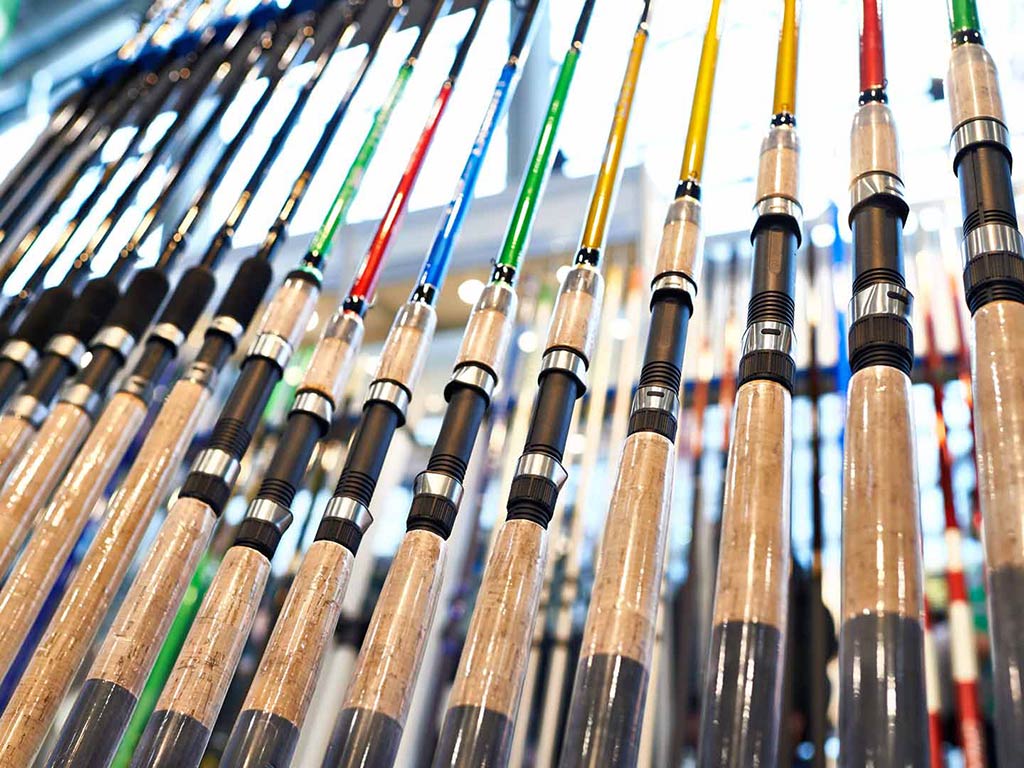Reading Time: 5 minutes
Affiliate Link Disclaimer
You’ve got the fishing trip of a lifetime all planned out. But before you pack for the flight, there are a few things you should know. These could be the difference between returning empty-handed, or with a full cooler. Today, we’re going to talk about traveling – well, flying with fishing gear!

There’s nothing worse for a traveling angler than being surrounded by hungry fish without your favorite lure!
You’ve got two (not mutually exclusive) options:
- Book a fishing charter that provides equipment (FishingBooker helps you do this worldwide).
- Travel with your own trusted gear (read on).
Depending on your destination and the amount of “cargo” your partner will put up with, today, we’ll show you a few packing tips that have worked well for countless others on their travels so far.
Flying with Fishing Rods: Travel vs. Trolling
Four-piece travel rods are great for light fly fishing or small lures, but what if you’re going after something bigger? Ask any serious international angler planning their trip to a coral-filled paradise – they’re going to bring at least two heavy trolling rods for the charter boat (just in case the equipment on board isn’t any good) and another four-piece travel rod for having fun from the beach.

According to the US TSA, you can take travel rods as carry-on luggage with you. I usually group them together in a short rod tube and haven’t had any trouble so far on local or international flights. To secure the rods additionally, tape them together or pack them in their original packaging so they don’t chafe during the ride too much.
What about heavier equipment like beach-casting or trolling rods? It might be a bit harder to get airport security to agree to let you carry these on the plane. Don’t worry though, you can check them in as sports equipment, and most airlines won’t charge you an overweight/excess baggage fee. That being said, be sure to check the website of the company you’re flying with about their sports equipment policy.
Tip for checking in rod tubes: Buy a hard-shell tube like Plano Airliner Telescopic Rod Case that supports a padlock or drill two holes into a soft-shell one so you can lock the zipper in place to avoid getting your rods stolen. It’s an unpleasant fact, but baggage theft does happen. Your job is to make the “prize” as hard to get at as possible.
How to Pack Reels
Since reels don’t have any dangerous parts, you shouldn’t have problems with reels from a security standpoint. If space permits, take your reels with you in your carry-on pack to prevent potential loss or damage.

Pack them in their original case, padded with a few socks or pairs of underwear, or buy a travel reel case for additional protection. Trolling reels will rarely fit into your carry-on luggage, so be sure to pad them well in your check-in bag.
Be aware that some airlines may require the line to be removed from reels before taking them on the plane as hand luggage. In order to avoid this situation, consider packing line separately in your hold baggage.
Can you bring lures and hooks on a plane?
According to the TSA:
“You may wish to pack expensive reels or fragile tackle that does not pose a security threat (small flies) in your carry-on bags.”
I disagree with this. Just check all sharp items. Taking a tackle box full of large hooks, lures, and flies is bound to give you trouble at airport security. They might let you enter the plane in the end, but only after a 30-minute argument with the security officer who’s probably clueless about fishing – and why you need a 3” fishing hook in your carry-on luggage!
If you absolutely must carry your lures with you, write an email to the airline asking about carry-on regulations for fishing lures/flies/hooks. If the response is positive, print it out and be prepared for a talk.
What about other equipment?
Obviously, knives and pliers won’t make it into your carry-on bag, but that’s not all you should consider.
Use common sense when traveling with fishing gear: knives, liquid fly floatant, and metal rod holders are definitely a no-no. Be sure to check these in. If you’re carrying lots of unusual equipment, show up at the airport an hour earlier than you normally would to allow for extra time if they make you check in anything.

Above all, don’t argue with the security staff. Be pleasant and tell a few fishing stories. They DO have the power to ban you from a flight. Another thing I often forget to do in the midst of pre-trip euphoria is to check my fly vest’s pockets for any leftover equipment.
Since 9/11, it’s been almost impossible to take dinghies and kayaks with you, checked in or not. If you’re staying at a 4+ star resort during your holiday, you’ll most likely have kayaks or pedalboats available for free or at a reasonable hourly rate.
Flying with Fishing Gear: It Doesn’t Have to Be Difficult

So there, you have it. You’re all set for your next fishing destination. Where to? Alaska? The Florida Keys? Maybe Mexico or the Maldives? All that’s left to do is, book a fishing charter, hop on that plane, and embark on the fishing trip of your life!
Have you tried traveling with fishing gear before? What was your experience like? Did you manage to get your favorite set to your fishing destination safely? Got any tips you’d like to share? Let us know in the comments below!
This article contains affiliate links (they’re bolded) and if you use them to buy your fishing gear, FishingBooker may earn a small commission. Thanks!











































